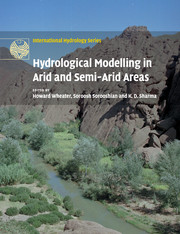Book contents
- Frontmatter
- Contents
- List of contributors
- Preface
- Acknowledgements
- 1 Modelling hydrological processes in arid and semi-arid areas: an introduction
- 2 Global precipitation estimation from satellite imagery using artificial neural networks
- 3 Modelling semi-arid and arid hydrology and water resources: The southern Africa experience
- 4 Use of the IHACRES rainfall-runoff model in arid and semi-arid regions
- 5 KINEROS2 and the AGWA modelling Framework
- 6 Ephemeral flow and sediment delivery modelling in the Indian arid zone
- 7 The modular modelling system (MMS): a toolbox for water and environmental resources management
- 8 Calibration, uncertainty, and regional analysis of conceptual rainfall-runoff models
- 9 Real-time flow forecasting
- 10 Real-time flood forecasting: Indian experience
- 11 Groundwater modelling in hard-rock terrain in semi-arid areas: experience from India
- Appendix Access to software and data products
- Index
- Plate section
- References
9 - Real-time flow forecasting
Published online by Cambridge University Press: 15 December 2009
- Frontmatter
- Contents
- List of contributors
- Preface
- Acknowledgements
- 1 Modelling hydrological processes in arid and semi-arid areas: an introduction
- 2 Global precipitation estimation from satellite imagery using artificial neural networks
- 3 Modelling semi-arid and arid hydrology and water resources: The southern Africa experience
- 4 Use of the IHACRES rainfall-runoff model in arid and semi-arid regions
- 5 KINEROS2 and the AGWA modelling Framework
- 6 Ephemeral flow and sediment delivery modelling in the Indian arid zone
- 7 The modular modelling system (MMS): a toolbox for water and environmental resources management
- 8 Calibration, uncertainty, and regional analysis of conceptual rainfall-runoff models
- 9 Real-time flow forecasting
- 10 Real-time flood forecasting: Indian experience
- 11 Groundwater modelling in hard-rock terrain in semi-arid areas: experience from India
- Appendix Access to software and data products
- Index
- Plate section
- References
Summary
INTRODUCTION
The primary objective of this chapter is to describe recent research on the design of real-time, adaptive forecasting procedures for the prediction of flow (discharge) or river level (stage) in river systems and to illustrate this with a case study based on data from a semi-arid river catchment in Western Australia. In particular, the aim is to produce an on-line, real-time approach to flow forecasting that is inherently stochastic and so able to predict not only the likely level of future flow, but also the uncertainty associated with this prediction. In this manner, the probability of a flood occurring in the near future can be quantified and this additional information can then be used as a basis for decision-making, operational management, and risk assessment in relation to the flooding of flood-prone locations.
The methodology described in subsequent sections of the chapter can be applied to the forecasting of either river flow or level. For simplicity, however, “flow” will be used here as a generic term to mean either of these two measures. Also, “flow” will be taken to mean the total flow in the river, not just the “run-off” component of total flow. In this context, the approach to forecasting described here is model-based, i.e., depending on the nature of the catchment and the forecasting objectives, the flow forecasts are based on an appropriate combination of stochastic, dynamic models for the relationships between: (i) rainfall and flow, and (ii) flow at various locations along the river, i.e. “flow routing” models.
- Type
- Chapter
- Information
- Hydrological Modelling in Arid and Semi-Arid Areas , pp. 113 - 138Publisher: Cambridge University PressPrint publication year: 2007
References
- 3
- Cited by



